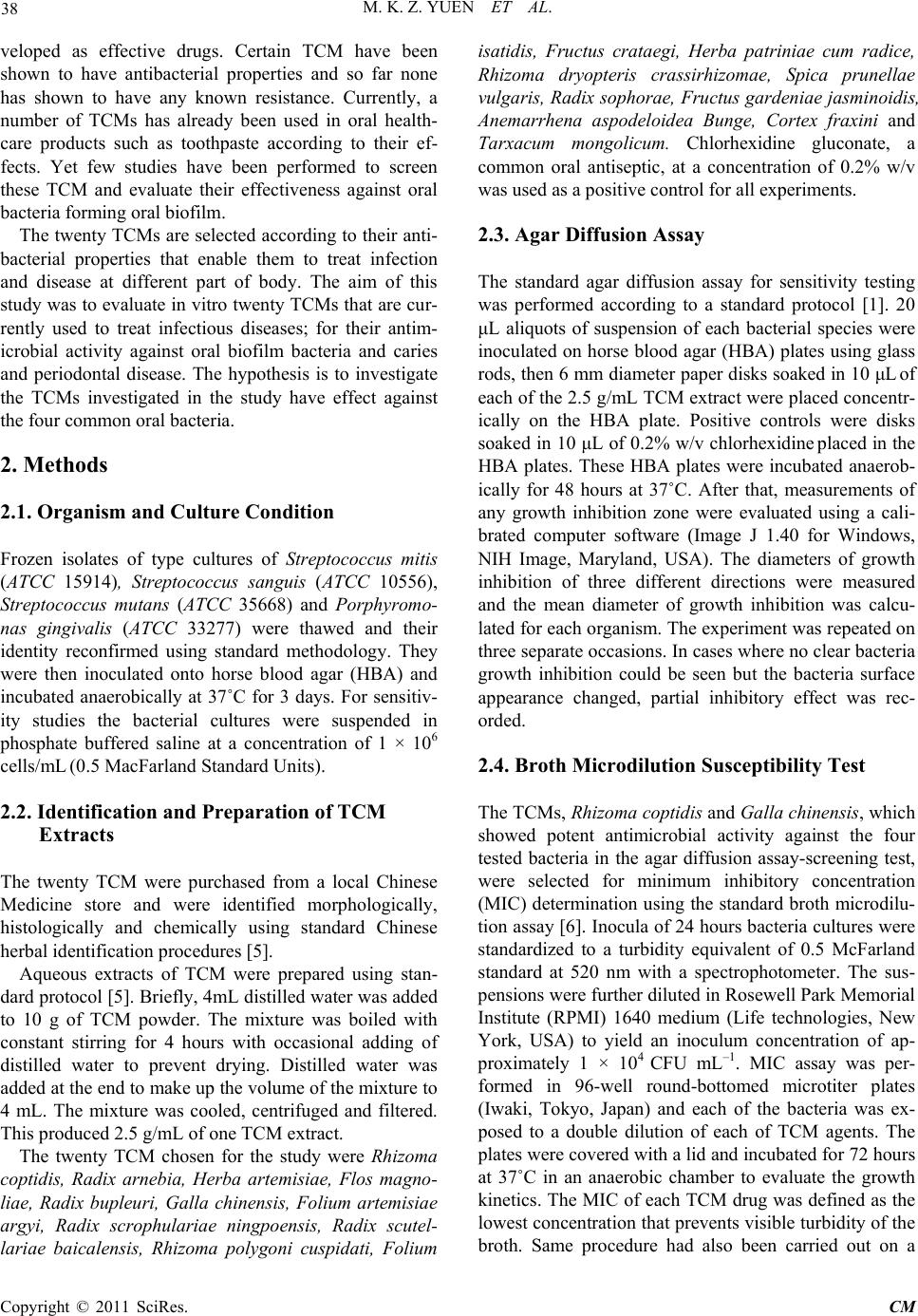
M. K. Z. YUEN ET AL.
Copyright © 2011 SciRes. CM
veloped as effective drugs. Certain TCM have been
shown to have antibacterial properties and so far none
has shown to have any known resistance. Currently, a
number of TCMs has already been used in oral health-
care products such as toothpaste according to their ef-
fects. Yet few studies have been performed to screen
these TCM and evaluate their effectiveness against oral
bacteria forming oral biofilm.
The twenty TCMs are selected according to their anti-
bacterial properties that enable them to treat infection
and disease at different part of body. The aim of this
study was to evaluate in vitro twenty TCMs that ar e cur-
rently used to treat infectious diseases; for their antim-
icrobial activity against oral biofilm bacteria and caries
and periodontal disease. The hypothesis is to investigate
the TCMs investigated in the study have effect against
the four common oral bacteria.
2. Methods
2.1. Organism and Culture Condition
Frozen isolates of type cultures of Streptococcus mitis
(ATCC 15914), Streptococcus sanguis (ATCC 10556),
Streptococcus mutans (ATCC 35668) and Porphyromo-
nas gingivalis (ATCC 33277) were thawed and their
identity reconfirmed using standard methodology. They
were then inoculated onto horse blood agar (HBA) and
incubated anaerobically at 37˚C for 3 days. For sensitiv-
ity studies the bacterial cultures were suspended in
phosphate buffered saline at a concentration of 1 × 106
cells/mL (0.5 MacFarland Standard Units).
2.2. Identification and Preparation of TCM
Extracts
The twenty TCM were purchased from a local Chinese
Medicine store and were identified morphologically,
histologically and chemically using standard Chinese
herbal identification procedures [5].
Aqueous extracts of TCM were prepared using stan-
dard protocol [5]. Briefly, 4mL distilled water was added
to 10 g of TCM powder. The mixture was boiled with
constant stirring for 4 hours with occasional adding of
distilled water to prevent drying. Distilled water was
added at the end to make up the volume of the mixture to
4 mL. The mixture was cooled, centrifuged and filtered.
This pro duc ed 2.5 g/mL of one TCM extract.
The twenty TCM chosen for the study were Rhizoma
coptidis, Radix arnebia, Herba artemisiae, Flos magno-
liae, Radix bupleuri, Galla chinensis, Folium artemisiae
argyi, Radix scrophulariae ningpoensis, Radix scutel-
lariae baicalensis, Rhizoma polygoni cuspidati, Folium
isatidis, Fructus crataegi, Herba patriniae cum radice,
Rhizoma dryopteris crassirhizomae, Spica prunellae
vulgaris, Radix sophorae, Fructus gardeniae jasminoidis,
Anemarrhena aspodeloidea Bunge, Cortex fraxini and
Tarxacum mongolicum. Chlorhexidine gluconate, a
common oral antiseptic, at a concentration of 0.2% w/v
was used as a positive control for all experiments.
2.3. Agar Diffusion Assay
The standard agar diffusion assay for sensitivity testing
was performed according to a standard protocol [1]. 20
μL aliquots of suspension of each bacterial species were
inoculated on horse blood agar (HBA) plates using glass
rods, then 6 mm diameter paper disks soaked in 10 μL of
each of the 2.5 g/mL TCM extract were placed concentr-
ically on the HBA plate. Positive controls were disks
soaked in 10 μL of 0.2% w/v chlorhexidine placed in the
HBA plates. These HBA plates were incubated anaerob-
ically for 48 hours at 37˚C. After that, measurements of
any growth inhibition zone were evaluated using a cali-
brated computer software (Image J 1.40 for Windows,
NIH Image, Maryland, USA). The diameters of growth
inhibition of three different directions were measured
and the mean diameter of growth inhibition was calcu-
lated for each organism. The experiment was repeated on
thre e separate occasions. In cases wh ere no clear bacteria
growth inhibition could be seen but the bacteria surface
appearance changed, partial inhibitory effect was rec-
orded.
2.4. Broth Microdilution Susceptibility Test
The TCMs, Rhizoma coptidis and Galla chinensis, which
showed potent antimicrobial activity against the four
tested bacteria in the agar diffusion assay-screening test,
were selected for minimum inhibitory concentration
(MIC) determination using the standard broth microdilu-
tion assay [6]. Inocula of 24 hour s bacteria cultures were
standardized to a turbidity equivalent of 0.5 McFarland
standard at 520 nm with a spectrophotometer. The sus-
pensions were further diluted in Rosewell Park Memorial
Institute (RPMI) 1640 medium (Life technologies, New
York, USA) to yield an inoculum concentration of ap-
proximately 1 × 104 CFU mL–1. MIC assay was per-
formed in 96-well round-bottomed microtiter plates
(Iwaki, Tokyo, Japan) and each of the bacteria was ex-
posed to a double dilution of each of TCM agents. The
plates were covered with a lid and incubated for 72 hours
at 37˚C in an anaerobic chamber to evaluate the growth
kinetics. The MIC of each TCM drug was defined as the
lowest concentration that prevents visible tur bidity of the
broth. Same procedure had also been carried out on a